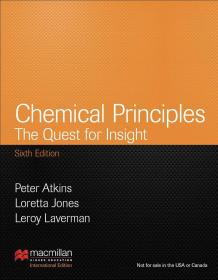
现货Chemical Equilibrium[9781682501672]
¥ 1434 九五品
仅1件
作者Hung-Sheng Tsai and Teh-Hua Tsai et al.
出版社Magnum Publishing LLC
ISBN9781682501672
出版时间2016-01
装帧精装
纸张其他
正文语种英语
上书时间2023-08-08
- 最新上架
商品详情
- 品相描述:九五品
- 商品描述
- Chemical equilibrium is the state in which both reactants and products are present in concentrations which have no further tendency to change with time. Usually, this state results when the forward reaction proceeds at the same rate as the reverse reaction. The text Chemical Equilibrium deals with the fundamentals of chemical equilibrium. The purpose of first chapter is to determine indium extraction equilibrium, using D2EHPA as an extractant and kerosene as a diluent to extract indium(III) from a nitric acid solution at 25.0 ± 0.2°C. In second chapter, we perform a comprehensive comparison between free and bioavailable copper determined using a Cu ion-selective electrode (Cu-ISE) and a Cu-specific bacterial biosensor. Third chapter synthesizes a new type of cross-linked chitosan with Diethylene Triamine, which has several amido groups. In fourth chapter, the mutual solubility of tocopherols from crude palm oil has been studied using carbon dioxide as a solvent at the temperatures of 80, 100 and 120°C. The electrical properties and chemical equilibrium of alginate complexes containing cross-linked tetravalent metal ions have been focused in fifth chapter. Efficient chemical equilibrium calculations for geochemical speciation and reactive transport modeling have been revealed in sixth chapter. The aim of seventh chapter is to assess the potentiality of Moroccan natural clays as a low-cost adsorbent for the removal of methylene blue, malachite green, and methyl orange from aqueous solution as an ideal alternative to the current expensive methods of removing dyes from wastewater. Eighth chapter focuses on equilibrium, kinetic and thermodynamic studies for sorption of Ni (II) from aqueous solution using formaldehyde treated waste tea leaves. Ninth chapter describes the possible valorization of two waste streams into activated carbon (AC) with added value due to copyrolysis. Tenth chapter reports the application of a straw ash from barley as a novel bioadsorbent for the removal of several heavy metals: Ni(II), Cd(II), Cu(II), and Co(II). In eleventh chapter, we focus on kinetic, equilibrium and thermodynamic studies of synthetic dye removal using pomegranate peel activated carbon prepared by microwave-induced KOH activation. The analysis of a new liquefaction combined with desublimation system for CO2 separation based on N2/CO2 phase equilibrium has been proposed in twelfth chapter. Thirteenth chapter focuses on charged colloidal rods out of equilibrium. For the extraction of univalent and divalent metal picrates, extraction constants without the interfacial equilibrium-potential difference have been proposed in fourteenth chapter. The aim of fifteenth chapter is to determine the potential of the dead biomass of Eupenicillium ludwigii to remove Ni2+ and Cd2+ ions in a batch mode and the function of many environmental factors such as pH, time contact, initial metal ions concentration, temperature, biomass dose, and shaking rate. In sixteenth chapter, equilibrium of caproic acid with aliquat-336, a quaternary amine compound, in xylene and Methyl isobutyl ketone has been studied. Seventeenth chapter evaluates the reliability and efficiency of eight selected nature-inspired metaheuristic algorithms for solving difficult phase stability and phase equilibrium problems. Equilibrium simulations of proteins using molecular fragment replacement and NMR chemical shifts have been proposed in last chapter.
相关推荐
-
![现货Chemical Thermodynamics[9781789223460]](https://www0.kfzimg.com/sw/kfz-cos/kfzimg/17733071/7b52de077a8646fc_s.jpg)
现货Chemical Thermodynamics[9781789223460]
九五品上海
¥ 1594.00
-
![现货Chemical Dynamics[9781682501733]](https://www0.kfzimg.com/sw/kfz-cos/kfzimg/17733071/97e7e8ef5332a586_s.jpg)
现货Chemical Dynamics[9781682501733]
九五品上海
¥ 64514.00
-

现货 Chemical Principles.
九五品上海
¥ 409.00
-
![现货Chemical Energy Storage[9783110608434]](https://www0.kfzimg.com/sw/kfz-cos/kfzimg/17733071/258d44677425dd90_s.jpg)
现货Chemical Energy Storage[9783110608434]
九五品上海
¥ 925.00
-
![现货Chemical Product Technology[9783110475319]](https://www0.kfzimg.com/sw/kfz-cos/kfzimg/17733071/a8e0891ab9b51196_s.jpg)
现货Chemical Product Technology[9783110475319]
九五品上海
¥ 566.00
-
![现货Chemical Process Control[9781781638675]](https://www0.kfzimg.com/sw/kfz-cos/kfzimg/17733071/5b916ebfb5e0f65e_s.jpg)
现货Chemical Process Control[9781781638675]
九五品上海
¥ 1867.00
-
![现货Chemical Data Collections[9781682504673]](https://www0.kfzimg.com/sw/kfz-cos/kfzimg/17733071/528aae704b83fe59_s.jpg)
现货Chemical Data Collections[9781682504673]
九五品上海
¥ 56925.00
-
![现货Integrated Chemical Processes[9781781545515]](https://www0.kfzimg.com/sw/kfz-cos/kfzimg/17733071/3983334ee0dd288d_s.jpg)
现货Integrated Chemical Processes[9781781545515]
九五品上海
¥ 1867.00
-
![现货 Chemical Principles: International Edition [9781464120671]](https://www0.kfzimg.com/sw/kfz-cos/kfzimg/defbfdff/3c5ed50d023a7315_s.jpg)
现货 Chemical Principles: International Edition [9781464120671]
九品上海
¥ 298.00
-
![现货Concepts Of Chemical Dependency[9781337563451]](https://www0.kfzimg.com/sw/kfz-cos/kfzimg/17733071/5002b82f0b8e4689_s.jpg)
现货Concepts Of Chemical Dependency[9781337563451]
九五品上海
¥ 1811.00
— 没有更多了 —
![现货Chemical Equilibrium[9781682501672]](https://www0.kfzimg.com/sw/kfz-cos/kfzimg/17733071/73be66a2ae165ecc_b.jpg)

![现货Materials and Technologies of Modern Production[9783036401683]](https://www0.kfzimg.com/sw/kfz-cos/kfzimg/17733071/5fd2824531e165d7_s.jpg)
![现货Introduction to Container Ship Operations and Onboard Safety[9781032155425]](https://www0.kfzimg.com/sw/kfz-cos/kfzimg/17733071/58b7ff43ef7909ee_s.jpg)
![现货Electrophosphorescent Materials and Devices[9789814877343]](https://www0.kfzimg.com/sw/kfz-cos/kfzimg/17733071/18cc1d77bcb7b488_s.jpg)
![现货Organic Semiconductors for Optoelectronics[9781119146100]](https://www0.kfzimg.com/sw/kfz-cos/kfzimg/17733071/24c85a750c708964_s.jpg)
![现货Advances in Food Rheology and Its Applications[9780081004319]](https://www0.kfzimg.com/sw/kfz-cos/kfzimg/17733071/e0c11603c9119d4d_s.jpg)
![现货Advanced Materials and Sustainable Technologies[9783035727562]](https://www0.kfzimg.com/sw/kfz-cos/kfzimg/17733071/dced675333874c48_s.jpg)
![现货Advanced Materials and Manufacturing Engineering II[9783035712681]](https://www0.kfzimg.com/sw/kfz-cos/kfzimg/17733071/660ccfae75fa8d3e_s.jpg)
![现货Materials in Machinery and Construction[9783035718119]](https://www0.kfzimg.com/sw/kfz-cos/kfzimg/17733071/6f402060775e9daa_s.jpg)
![现货Cereal Grain Quality (Softcover Reprint of the Original 1st 1996)[9789401071772]](https://www0.kfzimg.com/sw/kfz-cos/kfzimg/17733071/f93ca1c96a97403a_s.jpg)
![现货Chemical Equilibrium[9781682501672]](/dist/img/error.jpg)
以下为对购买帮助不大的评价